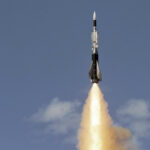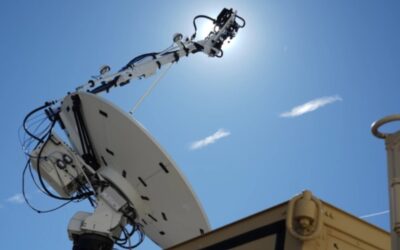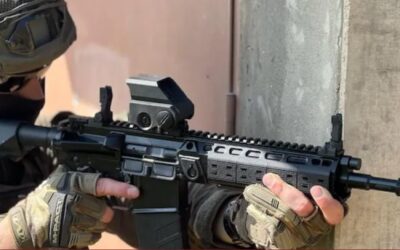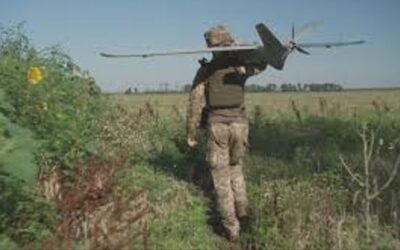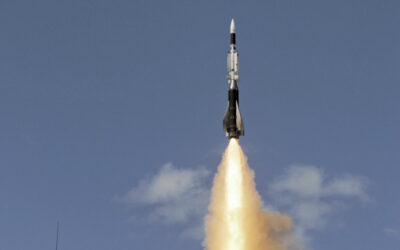The US Space Force has unveiled its new Remote Modular Terminal (RMT) weapon system. The system has completed its…
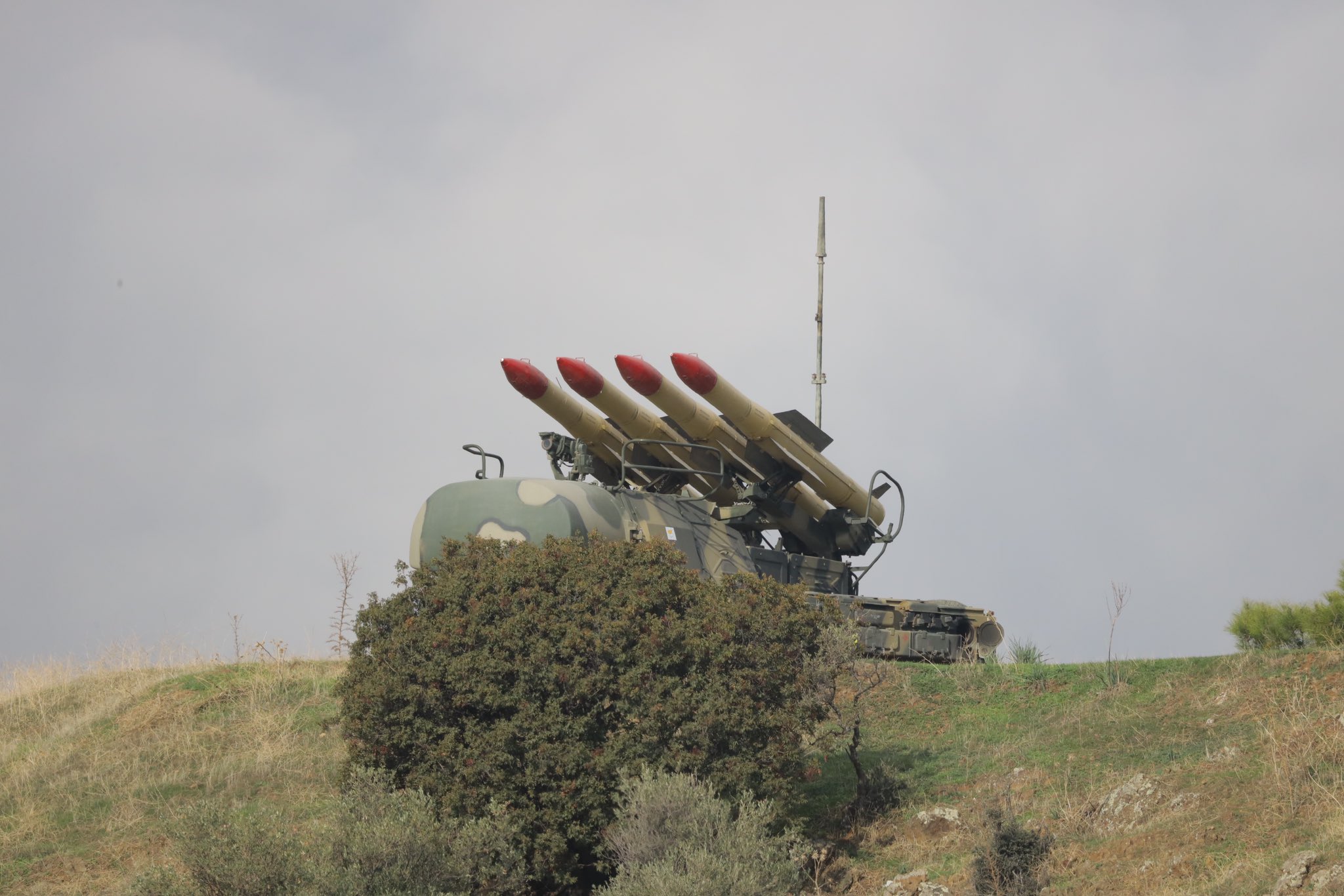
*Andreas Pogiatzis
In the first part we focused on options for replacing the Russian-made fleet of tanks and combat vehicles of the National Guard.
On the second and final part we will focus to options for replacing the Russian-made air defence systems and Multiple Rocket Launchers (MRLS).
According to open sources, the National Guard has the following Russian-made air defence and artillery assets:
- 4 BM-21 Grad MRLS
- A number of BUK M1-2 medium-range self-propelled anti-aircraft systems
- 6 TOR-M1 Self-propelled short-range anti-aircraft systems
- A number of trucks and support vehicles for the above equipment
Having not participated in the last “Nikitis – Dimitra 2023” exercise, the fleet of the 11 Mil Mi-35P gunship helicopters are expected to be sold in Serbia. The 11 helicopters will be replaced by 6 (plus an option for another 6) H145M helicopters ordered from Airbus.You can read more about the new helicopter of the National Guard here in an extensive presentation made during EUROSATORY 2022.
Also read: National Guard | The available options for new Helicopters
Taking into account the military conflicts of recent decades, the establishment of air superiority is the first and highest priority of all warring parties.
Hence the criticality of a properly structured, multi-layered air defence is vital to the extent that no military in the world has quite possibly achieved absolute countermeasures to air/ballistic enemy threats.
In the case of Cyprus, the establishment of an Air Force with manned fighter aircraft is difficult, thus we are focusing on the implementation of an effective anti-aircraft / anti-ballistic “umbrella”, in which the Cypriot Exclusive Economic Zone (EEZ) will be included in its entirety.
The replacement of the anti-aircraft systems of the National Guard will be a challenge for the Ministry of Defence, in order to fill the gap left by the Russian BUK M1-2 and TOR-M1, which are expected to be decommissioned in the coming years as their maintenance or upgrading is no longer feasible.
The two Russian-made National Guard systems (BUK M1-2 and TOR M1) are self-propelled and there are no similar options available in the West, especially in terms of mobility and range. You can find more about these two systems in the article links below.
Also read: BUK M1-2 “The spearhead of the Cyprus Air Defence” | VIDEO
In the years to come, the inherent philosophy of Cyprus’ Ground Based Air Defence (GBAD) will change, with the acquisition of western-made systems. Western made systems present some common characteristics in their design, architecture and integration. The main factor for western made systems is the cability of operating under a network-centric doctrine. Of course, these could not be possible without the appropriate means of surveillance and early warning, something which we will discuss in another article.
Also read: TOR M1 | The reliable SHORAD of the National Guard
The markets that Cyprus can focus are limited to Europe, the USA and neighboring Israel, with which, as we have already mentioned, a strong cooperative relationship is being developed at multiple levels.
Medium-range Air Defence (MRAD) options
BARAK MX – Israel
The Israeli industry offers multiple options in air defence systems for all ranges and altitudes.
The BARAK MX could be one option, with missiles belonging to the MRAD category or higher levels such as LRAD (Long Range Air Defense) and ER (Extended Range).
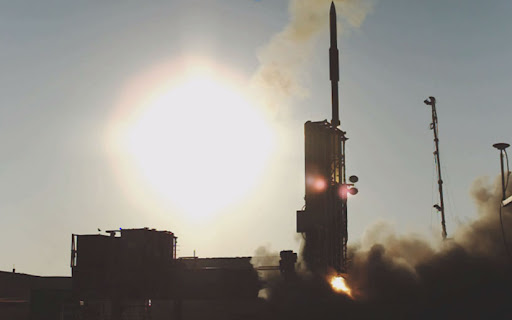 BARAK LR (LRAD) ©IAI
BARAK LR (LRAD) ©IAI
When the Israel Aerospace Industries (IAI) introduced the BARAK MX anti-aircraft system, this was described as revolutionary system because of its capabilities.
BARAK MX is a modular system which consists of three main parts. The first one is the Battle Management Center (BMC) available in portable, deployable or stationed configurations tailored to user needs.
BARAK MX’s BMC creates and manages a unified aerial picture from all available sensors.
The second key component is the effectors. The BARAK MX has three advanced missile types depending on the mission:
- BARAK MRAD: single-engine missile for a range of up to 35 km. Available in a self-propelled launcher
- BARAK LRAD: dual-stage engine missile for a range of up to 70 km. Available in a deployable launcher
- BARAK ER: dual-stage pulse missile with additional propulsion for reaching ranges up to 150 km, feaururing improved anti-ballistic capabilities. Available in a deployable launcher.
All launchers are vertically launched for 360 degree coverage and carry a load of 4 to 8 missiles (4 for MRAD – 8 for LRAD-ER). Depending on the version, the effectors have a maximum target engagement altitude of up to 30 km with maneuverability up to 50G. BARAK missiles use RF seeker sensors, designed to lock on targets with a low radar cross section (RCS).
 BARAK MX at EUROSATORY 2022
BARAK MX at EUROSATORY 2022
The third part of the BARAK system is the variety of sensors offered by IAI, specifically the company’s Active Electronically Scanned Array (AESA) radar available in various sizes and configurations. Existing radars and legacy systems under conditions can also be imtegrated with BARAK MX.
Morocco’s armed forces signed a contract last year worth about $500 million to acquire the BARAK MX without disclosing further details.
Also read:Morocco | Acquisition of the modern Israeli air defence system Barak MX
An article of the Greek website Doureios Ippos and Journalist Savvas Vlassis mentioned last year the acquisition of the Barak MX as a possible system by the Republic of Cyprus and not the Iron Dome, a topic which was first published by the newspaper “Kathimerini“. This information is not denied or confirmed by the Ministry of Defence of the Republic of Cyprus.
SPYDER – Israel
Another option Israel has to offer is the self-propelled SPYDER system from Rafael Advanced Defense Systems with a range variation beetween 20 to 80 kilometers, depending on the version.
This system (in the SHORAD version) will also be procured by the Czech Republic, which recently signed a contract with Israel worth 620 million euros (1 billion euros with follow-on-support over 20 years).
The SPYDER launcher is designed to launch PYTHON-5 and I-DERBY surface-to-air missiles which can also be launched from aircraft.
The PYTHON-5 missile has an infrared seeker (dual-band Imaging Infrared- IIR), while the I-DERBY has an active radar seeker (active BVR).
A typical SPYDER system battery consists of:
- A Command and Control Unit (CCU), mounted on a wheeled vehicle
- A radar which is either self-propelled or towed (in Short-Range and Extended Range versions the radar is integrated onboard the same vehicle as the CCU). In the SPYDER-MR (Medium Range) and LR (Long Range) versions it is towed. The system has an open architecture and allows the integration of various radar sensors, e.g. the Elta EL/M 2106 ATAR 3D radar
- 3-6 Missile Firing Units (MFU) with integrated TopLite Electro-Optical Sensor (EOS), and 4 missiles (any combination with PYTHON-5 and I-DERBY)
- Missile reloading vehicles
Also read: “SPYDER” | Multi-layered air defence by Rafael Advanced Defense Systems
NASAMS – USA / Norway
NASAMS, or National Advanced Surface-to-Air System, was the first network-centric, medium-range, anti-aircraft system capable of multiple and simultaneous beyond-line-of-sight (BLOS) engagements worldwide.
It was jointly developed by the Norwegian Kongsberg Defense & Aerospace (KDA) and the American Raytheon and has been in service since 1988 in various countries, including the Ukrainian Air Defence Forces (since 2022).
It is a modular system, constantly developing, highly transportable (even though it is non-self-propelled) with operational flexibility for the protection of critical infrastructures, populated areas, military installations and forward units.
The system has an open architecture, both in its components and in its software, and is designed to implement new technologies.
 © Raytheon
© Raytheon
Its flexible, operational configuration is characterized by its compatibility with other longer-range systems, such as the American Patriot, due to its task force-oriented architecture, allowing operators to optimize the effect of components and adjust the system in the work they perform (job at hand).
NASAMS uses the AMRAAM-ER medium-to-extended range missile, but also the AIM-9X2 for lower altitude targets.
Regarding its sensors, it feautures a Raytheon AN/MPQ-64F1 Sentinel 3D radar.
The Sentinel is a multi-role pulsed Doppler radar operating at the X-band frequency. The radar provides 360º surveillance, tracking coverage and target identification at a range of up to 120 km.
The cost of acquiring a NASAMS artillery is 240.5 million dollars, while the price of each missile may exceed 1.5 million dollars. The newest version, NASAMS 3, was developed in 2019, with the added capability of launching AIM-9X Sidewinder, IRIS-T SLS and AMRAAM-ER missiles.
VL MICA – France
MBDA’s Vertical Launch MICA (VL MICA) air defence system is a self-propelled ground-based short-range air defence (SHORAD) system with a maximum target engagement range of 20 kilometers.
The system uses the fire-and-forget MICA missile which is also used by aircraft or naval platforms and is the only one in the world to date with a heat-seeking warhead (VL MICA IIR) or an active radar detector (VL MICA RF).
This ability ensures a very high probability of kill (Pk), even in environments with strong IRCM (flares) and ECM (e.g. chaffs or jammers) interference.
The composition of a typical VL MICA unit consists of a mobile Tactical Operations Center (TOC), a mobile 3D radar and 3 to 6 vertical launchers with 4 missiles each.
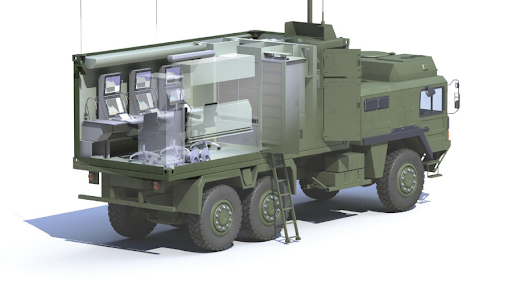
©MBDA
The TOC is capable of performing all Command, Control and Coordination functions, including real-time target engagement. Through the TOC it is possible to connect the system to higher echelons for full network-centric operation.
At this point we should mention that the very short range systems (VSHORAD) MISTRAL 3 (click here), which have already been purchased by the National Guard, may easily be integrated into a network-centric system of a wider coverage level such as VL MICA.
More specifically, through the TOC (also known as Platoon Command Post -PCP) coordination between V-SHORAD and SHORAD systems is possible such as, for example, four MISTRAL-3 missile launchers (on vehicles or mounted as MANPADS) and four VL MICA launchers as shown in the graph below:
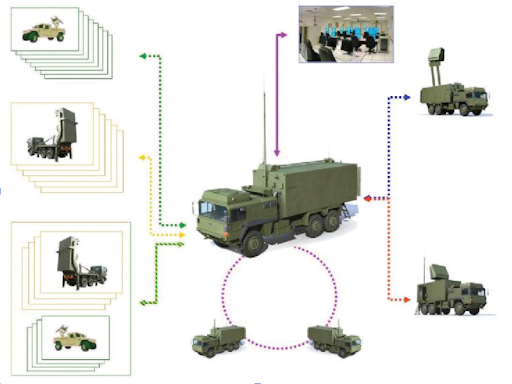 ©MBDA
©MBDA
MBDA, announced, that it is in the process of certifying the newest MICA NG (New Generation) missile to the existing VL MICA anti-aircraft systems. The two types (MICA and MICA NG) have the same external dimensions and the only modification concerns the software of the vertical launcher, which can carry 4 missiles of either MICA or MICA NG class with an IIR or RF detector.
The MICA NG which will replace the existing MICAs, in service with the French Air Force, will be available in 2026. The reduced volume of the electronic systems of the new missile will allow an increased amount of propellant providing additional kinetic energy during the terminal phase of target engagement in distances exceeding 40 km, effectively placing the system in the medium-range of anti-aircraft (MRAD) systems category. You can read more about VL MICA here.
CAAM – United Kingdom
MBDA also has the next generation CAMM (Common Anti-air Modular Missile) family designed for land, sea and aerial environments.
CAMM missiles incorporate advanced technologies to provide full protection against all known air targets. The CAMM missile will form the core of the land-based air defence version for the Royal Artillery.
CAMM missiles offer ground forces an effective and easily deployed Enhanced Modular Air Defence Solutions (EMADS) local air defence system, and are capable of operating either as stand-alone units or integrated into a network.
Technical characteristics:
- Minimum operational range: < 1 km
- Maximum operational range: > 25 km
- Weight: 99 kg
- Length: 3.2 meters
- Diameter: 166 mm
- Speed: Mach 3 (or 1,020 meters/second)
- Interface compatibility with existing targeting radars
The system has recently been selected by Poland for the price of $2.37 billion, with deliveries expected to be completed in 2023.
 CAMM ©MBDA-UK
CAMM ©MBDA-UK
IRIS T-SLM – Germany
The German Diehl IRIS-T SL GBAD system is available in three versions:
- The long-range IRIS-T SLX system as an extension of the basic one with a maximum range of 80+ km and a maximum engagement height of 30 km
- The medium-range IRIS-T SLM system with a maximum range of 40 km and a maximum engagement height of 20 km
- The short-range IRIS-T SLS system with a maximum range of 12 km and a maximum engagement height of 12 km
The medium-range version of the IRIS T-SL anti-aircraft system, the IRIS T-SLM, allows the simultaneous engagement of multiple targets, short and medium range, with extremely short reaction times, while it can provide comprehensive 360° protection from all aerial threats.
It can integrate different radar systems such as Saab Giraffe radar, CEA Technologies CEAFAR multi-role radar, TRML-4D and Terma A/S multi-role radar, and several battle control systems (BMC) such as Oerlikon Skymaster or Airbus Tactical Operations Center.
It is suitable for both mobile and fixed deployment. Its unit of 8 launchers is based on the MAN 8×8 vehicle chassis and is deployed in a vertical position to launch its missiles.
The IRIS T-SLM missile, the IRIS-T has a high-resolution infrared seeker with a wide field of view that enables close and very short-range air engagement as well as longer-range interception.
The excellent accuracy of the IRIS-T missile combined with the radar’s proximity safety enable the interception of enemy missiles.
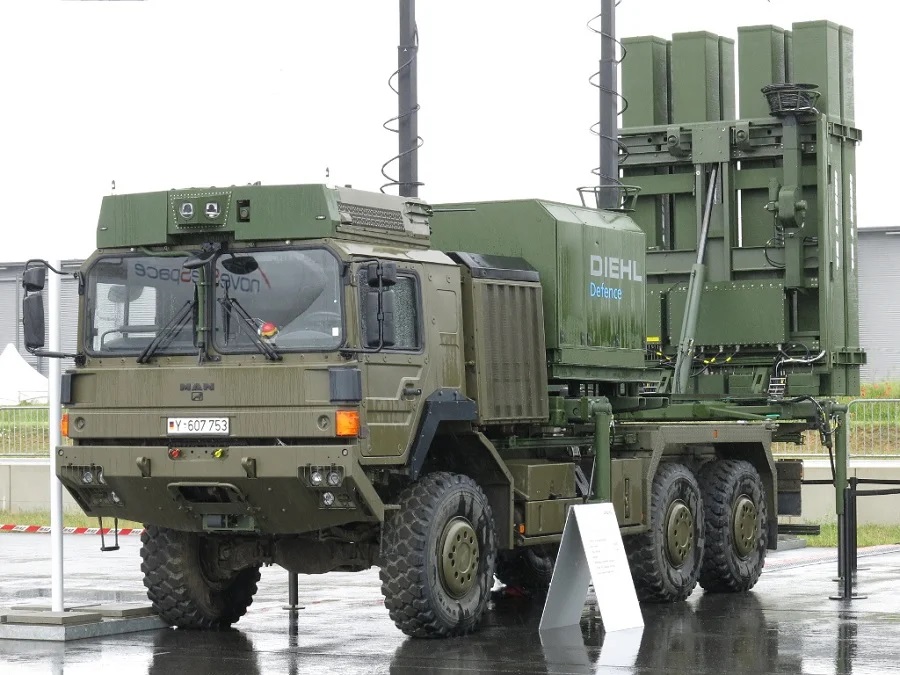 IRIS T-SLM ©Wikimedia Commons.
IRIS T-SLM ©Wikimedia Commons.
The system is chosen by Egypt and Ukraine with great success according to statements by officials.
🧵#IRIS_T_SLM 🇺🇦
1/4 Το GBAD σύστημα με αναφερόμενο ποσοστό επιτυχίας >90% είναι ίσως το ποιο περιζήτητο #battleproven ευρωπαϊκό σύστημα αεράμυνας μέσου βεληνεκούς αυτή την στιγμή. Στις φωτογραφίες που υπάρχουν στο διαδίκτυο φαίνεται ότι οι εκτοξευτές των Ουκρανικών ΕΔ φέρουν ⬇️ pic.twitter.com/KXQ5KR17uF— DEFENCE ReDEFiNED (@Def_Redefined) April 22, 2023
https://twitter.com/Def_Redefined/status/1649781357030129665?t=2vH4uNShhzCcKz6hh_Iz5g&s=19
The cost of acquiring an IRIS T-SLM artillery is reportedly around 250 million euros.
Also read: IRIS-T SLM GBAD system | Egypt’s choice to boost air defence – PHOTOS & VIDEO
Options for SHORADS
Stryker A1 IM-SHORAD – USA
Regarding the SHORAD systems, to replace the TOR-M1, there is nothing comparable in the European and Western markets. One of the options the West offers for short-range cover is the self-propelled Stryker A1 IM-SHORAD.
The system is a joint venture of General Dynamics Land Systems, Leonardo DRS and Raytheon.
The IM-SHORAD is installed on the Stryker A1 8 × 8 armored vehicle, equipped with a Caterpillar C9 450hp engine.
It is also equipped with a full range of sensors such as an Identification Friend or Foe (IFF) antenna as well as the Israeli’s Rada Hemispheric Multi-Mission Radar (MHR).
Also read:Stryker A1 | Interim Maneuver Short-range Air Defence Vehicle – VIDEO
The Stryker can fire different weapon configurations, including a pair of AGM-114L Longbow Hellfire missiles for air and ground targets and has a quadruple Raytheon Stinger launcher to engage aerial threats at ranges of up to 3 miles.
 Stryker A1 IM-SHORAD © Leonardo DRS
Stryker A1 IM-SHORAD © Leonardo DRS
Crotale NG – Mission Shield 100 – France
It is an upgraded version of Crotale NG in service with the Hellenic Armed Forces. The Crotale NG – Mission Shield 100 combines the Shikra multi-beam search radar, with a detection range of 150 km, Crotale Mk3 VT-1 missiles and a range of 15 km.
The system is mounted on both wheeled and tracked vehicles, depending on the user’s needs. The Crotale NG also integrates its on-board radar and can be linked to other sensors, launchers and control centers, to achieve an air defence grid.
The Crotale NG can track 8 targets simultaneously like fighter jets, at a speed of less than Mach 2. It can also process the data it receives from other systems and work as a unit in a national air system.
 Crotale (Multi-Mission 100) ©Wikipedia Commons
Crotale (Multi-Mission 100) ©Wikipedia Commons
Regarding the options for the remaining short-range systems (VSHORADS), they have been extensively referred to by DEFENCE ReDEFiNED, in collaboration with Amyna and Geostratigiki, in the 4th part of a series of articles on Turkish air defence and the solutions for Greece and Cyprus. You can read the relevant article here.
IRIS-T SLS Mk III
The DEFENCE ReDEFiNED team visited Diehl’s booth at the EUROSATORY 2022 Defence and Security exhibition and spoke with the company’s officials about the exhibits on display, most notably the new IRIS-T SLS Mk III air defence system.
The system is based on the IRIS-T anti-aircraft missile and is designed for a wide range of missions.
You can find more about this system that will possibly enter production in the future here.

Options for replacing BM-21 Grad MRLS
Regarding the artillery of the National Guard, as we have stated, great effort has already been made with the introduction of 2 NORA B52 batteries into service and the future reinforcement with Tamnava MRLS which will be important force multipliers.
Also read: Tamnava MLRS | High firepower with the ability to launch 122 and 262 mm rockets
The BM 21 Grad is a combat proven system which is still used in the war in Ukraine. It may possibly be upgraded to the standards of the Serbian Armed Forces Oganj MRLS rather than be decommissioned.
Also read: Multiple rocket artillery “Oganj” is modernized for the Serbian Armed Forces
Epilogue
Through the two articles, we have sought to focus on the particularities and challenges in replacing the Russian-made armament of the National Guard. The decommissioning of the systems after five years is, among other things, expensive and requires careful planning since any new systems should be in service for at least 20-30 years.
Hopefully we will soon have the first tangible samples of the entire effort made.
READ MORE
ASCANIO | Made-in-Cyprus Mixed Reality training
https://defenceredefined.com.cy/ascanio-made-in-cyprus-mixed-reality-training/Technology is advancing at an accelerated pace and so do the training requirements of those holding high-risk positions.
IWI | Introduces Micro Folding Battle Sights to enhance Co-Witness capabilities
IWI (Israel Weapon Industries), a member of the SK Group, has unveiled its new Micro Folding Battle Sights (MFBS).
Hellenic Entrepreneurs Association | Ideas & Positions for the Promotion of Greek Entrepreneurship
The members of the Hellenic Entrepreneurs Association (E.E.N.E.) participated in a roundtable discussion entitled “Ideas, Positions…
Ukraine | Increase in defence spending by 367 million euros for the acquisition of drones
Kiev is increasing spending by 15.5 billion hryvnias (367 million euros) to bolster Ukraine’s armed forces with drones, according to…
HMoND | The legislative initiative for HCDI is under consultation
The legislative initiative of the Ministry of National Defence, under the title: “Establishment of the Hellenic Center for Defence…
Russia | Cluster bombs hit residential area in Odessa
Images from Russia’s strike in the heart of Odessa, which hit the so-called “Harry Potter Castle”, a former politician’s mansion now…
France | Industries prioritize orders of anti-aircraft missiles
The Armed Forces Ministry of France has instructed industries involved in the production of Aster anti-aircraft and anti-ballistic…
Ecuador | Appeals to International Court of Justice denouncing Mexico
Ecuadorian police stormed the Mexican embassy hours after the Mexican government granted former Vice President…












